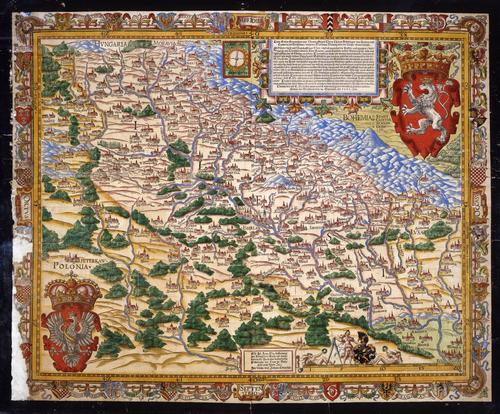I'm glad you rewrote it, because I just want to say, this is a great post.
Yep...and there were also a lot of smaller towns (mediatstadt) which were kind of in between. For example, check out this wonderful map of Silesia drawn by Martin Helwig's in 1561In 12th century germany, there are incredibly huge differences depending on time, place, ruler and political / military context.
In ancient times, all free german men were required by law to keep weapons for the purpose of defending their community. This changed with the advance of feudalism and serfdom, which, at least in theory, involved servitude to a lord as a trade-off for military protection provided by said lord an his men. For villagers, this "taming" removed the need or even right to bear arms, thus retarding their military ability. Note that it took until well after the Thirty Years' War of 1618-1648 (during which groups of desperate peasants banded together and butchered entire platoons of marauding mercenaries) until serfdom was completely established throughout all of germany. Also note that (free) cities are very different from villages.
Click here for more detail:
http://upload.wikimedia.org/wikipedi..._Schlesien.jpg
There is one 'big' town on that map, Breslau (now and aka Wroclaw) which was essentially a free city, that turned out to have near impregnable defenses. But the dozens of other settlements shown on that corner of the map like the wonderfully named 'monsterburg' and 'frankenstein' are small towns or villages incorporated with castles which in both cases did have some fortifications and defensive abilities, (since Silesia was a dangerous frontier area) but often only the citadels and the big free cities could resist major invasions.
Moving especially into the 13th -15th Centuries you would see more and more of these kinds of peasants brought into basically the entire eastern half of Germany and in large numbers into the Eastern Central European regions like Silesia, Poland, Prussia, the Baltic areas (Livonia), Czech, Hungary and etc. Events like Mongol invasions starting in the 1240's would leave large areas depopulated, tougher peasants were lured from places like Saxony and Swabia (and also from Slavic zones like Bohemia and Poland, and even further afield such as Sweden and Flanders) with special offers of rights and land grands (no money down! First year interest free!)Off the top of my head, I think there were at least three types of peasants / villagers (in matters of military strength) in the 12th century:
1. Wehrbauern (~defending peasants, not to be confused with the nazi attempt to revive that concept)
Mostly colonists near hostile borders, these men have the right and duty to keep weapons. Many have a military background of some kind. In case of an attack, it is their express purpose to defend their territory until their liege assembles a more powerful force. I guess this involves the defense of fortified places and skirmishing.
These folks ended up being pretty tough, but relied both on fortifying their towns and on natural defenses such as forests, hills, and rivers (many settlements were made on river islands)
Another way they survived during times of real danger, which I think gamers should generally find very interesting, are so called Earth-stalls or Erdstall. Don't have time to get all into it but I recommend further research
http://en.wikipedia.org/wiki/Erdstall
https://www.google.com/search?q=erds...KeTc2AWO1IDYDg
The Teutonic Knights made use of a lot of men like this in Prussia, Livonia and surrounding areas.2. Freisassen (~yeomanry)
Those are free men possessing property, often in wild, untamed regions and independend from a lord protecting them. As such, they should have a vested interest in defending themselves. I would expect a well-off estate to have some weapons or dangerous implements such as axes or hunting bows and at least a handful men of age ready to use them in an emergency.
http://upload.wikimedia.org/wikipedi...g_13r_Mars.jpg3. Leibeigene (~bond-slaves)
Generally speaking the most defenseless group, if their lord for whatever reason neglects his duty to protect them. They are often quite poor and have to work hard, so they have little resources to spend on proper weapons or training to use them.
An example of a typical raid on a more or less defenseless village from 1480, but it probably holds true for 1180 as well. Note that most of the villagers are holding out in the church ... usually whatever stone or brick buildings like the church or the granary doubled as a fort.
G
View Single Post
-
2012-10-21, 06:19 PM (ISO 8601)Ogre in the Playground

- Join Date
- Oct 2009
- Gender

 Re: Got a Real World Weapons or Armour Question? Mk XI
Re: Got a Real World Weapons or Armour Question? Mk XI





 Reply With Quote
Reply With Quote